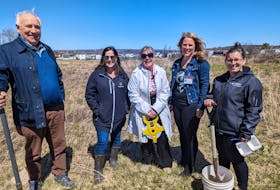FORT LAWRENCE, N.S. – Cumberland County’s historic Chignecto Marine Ship Railway is getting international exposure.
A film crew from the British Broadcasting Corporation was in Fort Lawrence on July 27 to do a preliminary inspection of the site and the complete crew will return later in August to do the actual filming for a segment on the BBC’s Great American Railway Journeys.
The TV series explores the impact of railways on North America and its success as a world leader in commercial activity.
“Had the Chignecto Ship Railway been completed, it would have provided a unique form of transport which could be used as a model for many other countries,” Cumberland Colchester MP Bill Casey said. “For this reason, the BBC has determined that it should be part of the story about North American railways.”
Sometimes called Ketchum’s Dream, the ship railway was the brainchild of civil engineer Henry Ketchum, who in 1875 proposed building a railway for ships across the Isthmus of Chignecto at its shortest point from the Bay of Fundy at Fort Lawrence to the Northumberland Strait at Tidnish – shortening a trip between the bay and the Gulf of St. Lawrence by about 930 kilometres.
The project would see ships lifted out of the water at one end and onto a rail car for transport then place it back in the water at the other end using a hoist and lock system.
Ketchum submitted his proposal to the fledgling Canadian government in 1881 and construction began in 1888. It was three-quarters completed in 1890 when financial problems hit the project, causing it to grind to a halt in 1891. The federal government refused to extend its support of the project and Ketchum himself died suddenly in Amherst in 1896.
Casey’s family owned the 142-hectare, 27-kilometre long property for more than 40 years before selling it to the province in February 2012.
Casey hopes this exposure may entice the province to further protect the site and potentially develop it as a tourist destination.
“I think it will give the area good exposure and give attention to the ship railway, which it needs,” he said. “It’s one of only 34 national historic civil engineering sites in Canada and it should be recognized. Hopefully this exposure will help get that recognition. It’s a tremendous part of our engineering and seagoing history.”
While at the site, the BBC crew examined much of the documentation available, including a copy of the original deed plan. The plan, more than 20 feet long, outlines every aspect of the roadway and the challenges involved in the construction.
Crew members Rosalind Hill, Ben Rowlan and Louis Sarinha visited the Bay of Fundy end of the railway and walked along the rail bed. They climbed on the stone foundations of the machinery used for the hydraulic lifts and has a close look at many of the remaining barrels of concrete left from construction – including 197 at one location alone.
The wood of the barrels has disintegrated and the steel hoops have almost all disappeared, but the concrete has turned into cement and they are still piled exactly as they were left in 1890.
The crew also filmed downtown Amherst including the Tupper Building, once owned by Sir Charles Tupper who was instrumental in the development of the Chignecto Ship Railway.
At the time, Tupper served as the minister of railways and canals and in 1896 served as prime minister.
He was instrumental in provincial and federal politics for much of his life.
Casey said the BBC crew was surprised to learn Tupper was born in Amherst and was one of Canada's founding fathers. He served in Britain as Canada's High Commissioner, and also became a member of the British Privy Council.
Twitter: @ADNdarrell









